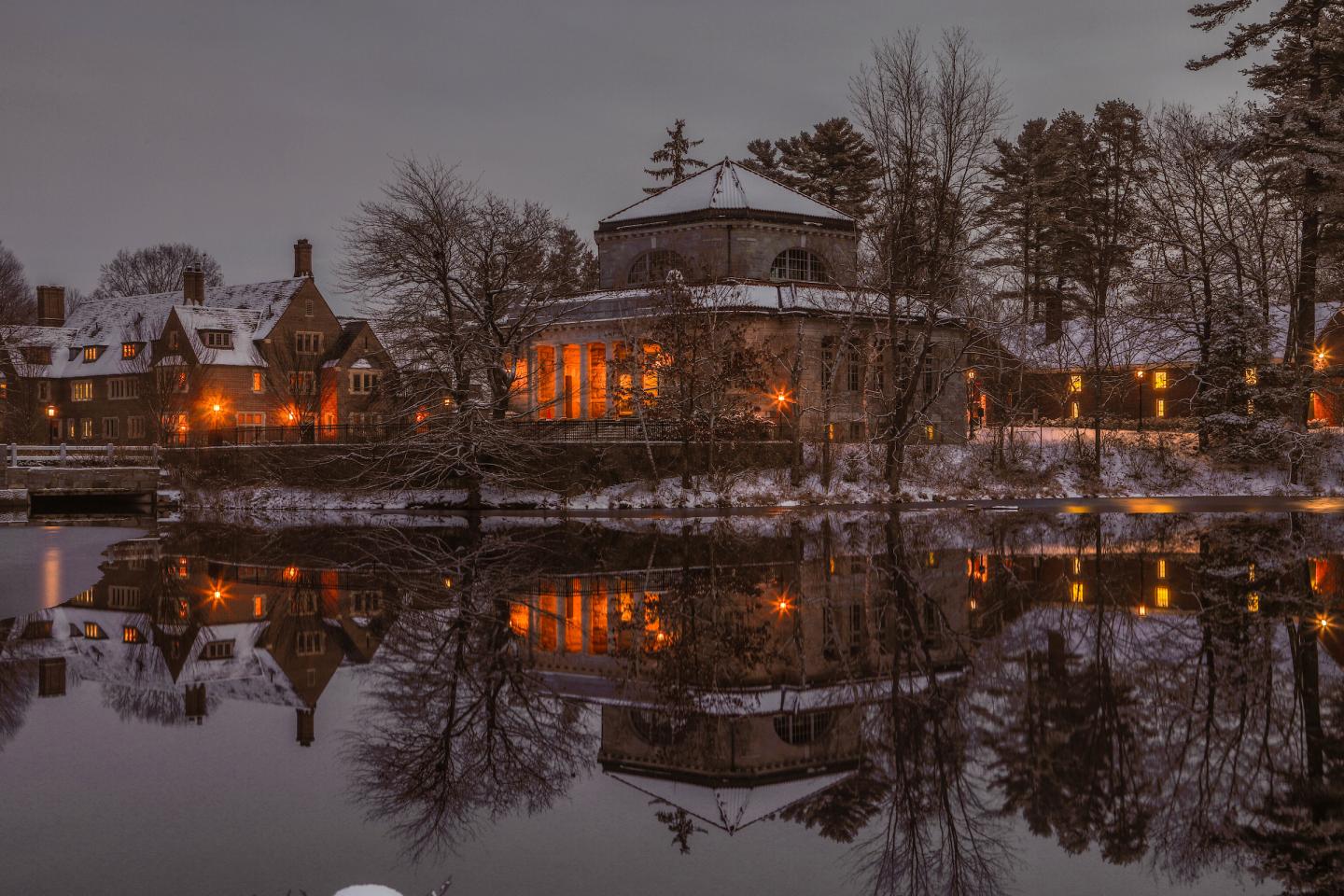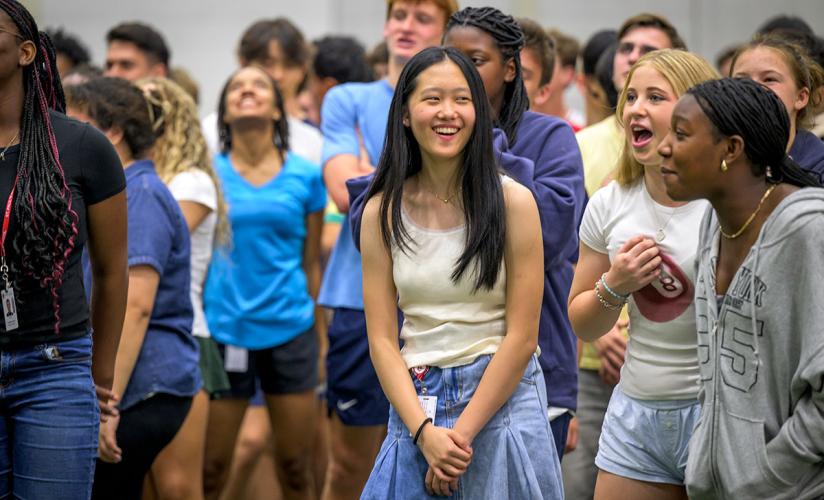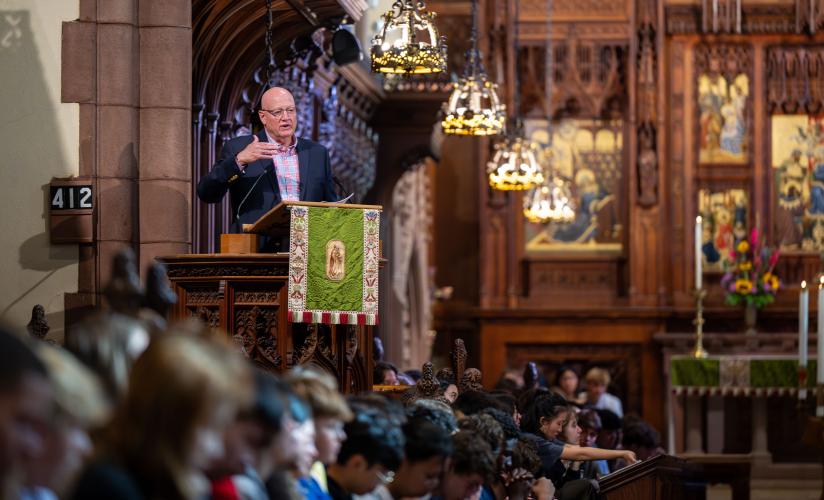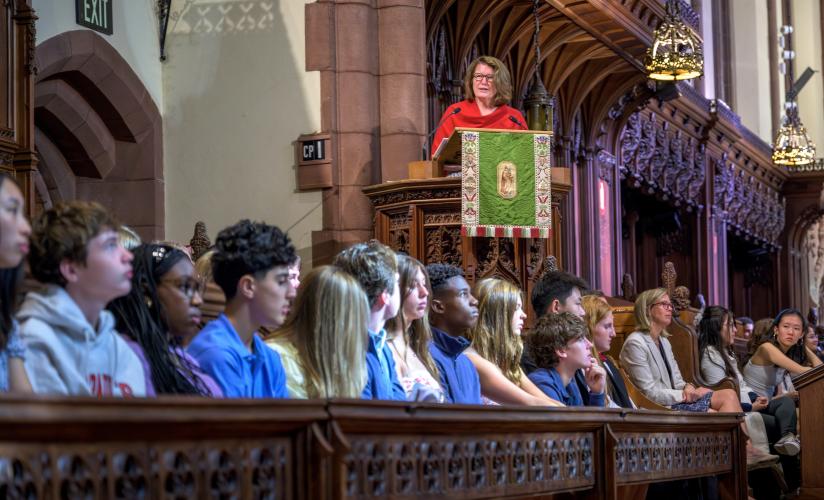

As Winter Term begins, Rector Kathy Giles spoke about the importance and meaning of light
Good morning, welcome back to School, and welcome to Winter Term. I have a renewed sense of gratitude, being here today, given that last year, we were remote through really the end of January. This year, there is a lot to look forward to in the coming weeks — “The Nutcracker,” Lessons and Carols, games and tournaments, [and] some fun holiday events. There’s a dusting of snow around the grounds, and there is super-thin, fragile, early ice forming around the edges of the ponds. And there is that telling winter chill in the air. Even with the added daylight-boost of the end of daylight savings time, it is dark early in the afternoons and relatively late into the mornings. The prospect of the next three months of dark, cold winter days, even for the winter sports lovers among us, can be daunting. And the way we take on that intimidation is to push back the darkness with light.
Or lights — many of them, configured in everything from fantastic blow-up displays like the Santa that has replaced that awesome Thanksgiving turkey on Mr. Cabot’s front porch to tastefully decorated trees and shrubs to herds of light-up reindeer. I am a huge, huge fan of holiday and winter lights. One of the best friendship gifts I ever was so lucky to receive was at my former school where, after a particularly challenging end of fall left me feeling deflated and a little defeated, I was trudging home one really cold, dark early evening in December when I looked up to see a herd of 26 light-up reindeer arranged with love and care on the lawn in front of my house. Bucks, does, fawns, some stationary, others moving. En masse, fully lit, they were absolutely spectacular, and yes, I cried. I suspected right away who did it — a wonderful colleague with a Ph.D. in instrumentation who shares my love of holiday lights, aided and abetted by a brilliant senior who loves circuits and programming and knows kindness and goodness in his core being. Yes, they did it. This herd was brilliantly engineered; it was configured and designed to be turned on and off with one click of a button. I know now that these wonderful people had canvassed campus searching out contributions and stragglers to pull together the herd, so a lot of people had contributed. It was a wonderful thing on campus that December — not just the display, but the gift of it that turned out to be a gift to everyone who knew the story behind our herd. I will never forget that vision, those … lights in the darkness of what felt, to me, like a dark time — and while I don’t remember now why I felt that way, I will never forget the kindness of those wonderful people. A herd of glowing, lit-up reindeer on a dark, cold winter’s night is exactly what kindness looks like, to me. The light that pushes back the darkness and replaces it with something bright and warm, hopeful and inspiring.
At this time of year, this time when it is dark early and late, we need to turn toward light. Today’s Opening Sentences make this point brilliantly across faiths represented in our community, and the word “enlightenment” carries powerful, inspirational connotations across the full spectrum of intellectual and secular, as well as spiritual, life. If we are enlightened, according to Buddhism, we have done the work to achieve a state of perfect freedom, in which we are awakened to the eternal and ultimate truth that is the reality of all things. We are freed from the cycle of rebirth — in short, we have conquered death because we understand and can live with eternal truth. If we are enlightened, according to the Western intellectual tradition of the 17th and 18th centuries, we embrace knowledge and understanding through reason toward a true understanding of ourselves and our world, particularly the physical world. Notice again the role that truth plays in enlightenment. The truth is that there is always darkness — physical darkness at 4:30 p.m. in the coming days; spiritual darkness in the face of uncertainty, anxiety, and loss as we all continue to work through this multi-phased, dynamic pandemic; and emotional darkness, when we don’t make the varsity [team], the exam did not go well, the college news is not what we hoped. These and more can all be uncomfortable truths in everyday life, and they can plunge us into darkness — and whenever we can, however we can, we can choose to turn toward the light.
Light abounds. The lights of Diwali, earlier this fall; the light of candles — the light of the Menorah candles that celebrate Hanukah now; the light of candles in churches that will celebrate Christmas; the light of candles that will celebrate Kwaanza, after Christmas. Funny how these celebrations — all of them celebrations of courage, commitment, and love — are happening … at the same time of year when darkness can be most daunting before the winter solstice, after which days start to lengthen again in the long but steady journey toward spring. There is a lot of history behind why we celebrate Christmas when we do, and I believe it is fair to say that the consensus is more about darkness and light than it is about the exact calendaring of Jesus’ days. Light defies darkness; light pushes back darkness; light restores confidence and faith and shows the way. Probably the most remarkable Christmas service I ever attended was completely without the beauty and grandeur of a cathedral such as this one, without the glorious organ and magnificent choir that we will enjoy in the coming celebrations here, without snow or any traditional Christmas packaging. This celebration took place in a very small, humble church in a rural village, into which my family and I entered by the light of very few candles on a Christmas Eve some years ago. We were strangers, and we were welcomed as people pointed out seats for us and shook hands and wished us good and wished us well. Just before midnight, the candles were snuffed; the lone church bell rang, and a very elderly priest called out from the back, paraphrasing the prophet Isaiah, “The people in darkness have seen a great light!” And with that, a lone hanging light bulb flashed on above us, and a woman with a guitar started singing, “Hark the Herald Angels Sing,” and everyone in the crowded little church joined in, and the very elderly priest processed to the front, singing loudly with the most beautiful, joyful smile on his face. He conducted the service with that same joy, that wonderful sense of excitement and celebration, and he changed the way I understand and love Christmas forever. Christmas reminds us that the birth of a child is always and forever a miracle, because every one of us is a child of God and made in God’s image. As a parent and grandparent, Christmas reminds me of the love of a mother and father, that unconditional love Mr. Odom spoke about in his Chapel talk, to be revered always and forever. But the bringing of light to mankind — truth, understanding, sacrifice, and love — to a people in darkness, is of an extraordinarily, amazingly, entirely different dimension. It is a mystery and miracle to reflect on throughout the days of our lives, as our experiences deepen and enrich our understanding toward that ultimate relationship with truth.
That we can think of ourselves — individually and collectively — as a people in darkness is quite clear. There is more than enough bad news to go around. We continue to futz our way through a pandemic that refuses to quit, that continues to surprise. We suffer from misinformation, denial, and untruths in ways that lead us continually into confusion and distress. All true. But while we might be a people in darkness, there is no need for us to be a people of darkness. To turn toward the light in our lives — and everyone here has many lights in our lives — we have to choose to look for it; we have to choose to see it, even if it sometimes seems faint or flickering; we have to choose to turn toward it; and we have to choose to be in the light, to push back the darkness, and to let our own lights shine in turn for those around us, even and perhaps especially if we are not at all sure that our light can be seen. It doesn’t have to be perfect to be beautiful, and we don’t have to be perfect to be beautiful, either. The choices make all the difference, in terms of making sense and meaning of this life, becoming increasingly enlightened, allowing the light to fill us. Last year at just about this time, when we were all “remote,” on the dark early evening of December 9th, my oldest daughter called to say that she was in labor and getting ready to have her much-awaited baby, albeit five-plus weeks ahead of schedule. Little Liam arrived later that night, an absolutely beautiful preemie at 5 pounds, and Mr. Giles and I hurried down to pick up the dog and do a little unpacking, as our daughter and her husband had just moved into a new place. As we got back to New Hampshire that night, quite late, it was an absolutely crystal clear, deeply black sky. The Geminid meteor shower captured our attention for some time, and then Mr. Giles pointed at a particularly bright star, relatively close to the horizon toward the East.
“That’s the Liam star,” he told me. Immediately, I thought, no dear, that’s Rigel, the front foot of the constellation Orion. But I looked at him as he looked up at that star in the East, and I decided that whatever was emitting that brilliant, hopeful light in the dark night could be both Rigel and the Liam star. Now we look for it every night. There is a saying attributed to the scientist Galileo in which he offers his philosophy of life with the statement, “I have loved the stars too fondly to be fearful of the night.” I understand that saying so much more, now that I look for the Liam star every night.
As we contemplate ourselves and our place in a vast, complex, amazing and mysterious universe, there is a very important truth to be had in Galileo’s profession of faith, for us. The light of truth, the light of love, the light of our gratitude and optimism against the dark — we love those lights too much to be fearful of the dark. We are called over these coming weeks and months to be people who find, see, and turn toward the light in our lives and in the people around us. So over these coming weeks of early and late darkness, we celebrate light — we defy the dark, we turn on candles in the windows and lights around trees and wonderful blow-up lawn displays and herds and herds of reindeer — as we choose to let our lights shine and to seek out and love the light in the people around us.



